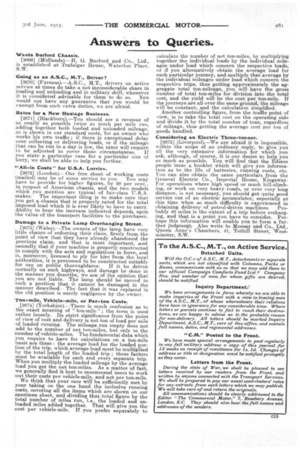Answers to Queries.
Page 17

If you've noticed an error in this article please click here to report it so we can fix it.
Wants Burford Chassis.
[2669] (Midlands).—H. G. Burford and -Co., Ltd., is established at Trafalgar House, Waterloo Place, S.W.
Going as an A.S.C., M.T., Driver?
[2670] (Furness).—A.S.C., M.T., drivers on active service at times do take a not inconsiderable share in loading and unloading and in military drill, whenever it is considered advisable for them to do so. You would not have any guarantee that you would be exempt from such extra duties, we are afraid.
Rates for a New Haulage Business.
[2671] (Blackburn).—You should see a revenue of as nearly as possible twice as much per mile run, adding together both loaded and unloaded mileage, as is shown in our standard costs, for an owner who works his own traffic ; if there is exceptional delay over collecting or delivering loads, or if the mileage that can be run in a day is low, the rates will require
to be adjusted to cover those circumstances. If you state a particular case for a particular size of lorry, we shall be able to help you further.
"All-in Costs" for U.S.A. Lorries.
[2672] (London).—Our free sheet of working costs (mailed) may be of some service to you. You may have to provide for higher figures by 20 per cent., in respect of American chassis, and the two models which you mention are typical of fair-class U.S.A. makes: The important thing is to make sure that you get a chassis that is properly rated for the total imposed load which it is ever likely to have to carry. Ability to bear the increase indicated depends upon the value .of the transport facilities to the purchaser.
Damage to a Private Lamp Overhanging Street.
[2673] (Wales).—The owners of the lamp have very little chance of enforcing their claim, firstly from the 'point of view that they have already abandoned the previous claim, and that is most important, and secondly that if your machine is properly constructed to comply with the acts and regulations in force, and is, moreover, licensed to ply for hire from the local authorities, it is presumed to be constructed suitably for use on public thoroughfares. If it be driven normally on such highways, and damage be done in the manner you describe, we are of the opinion that you are not liable. The lamp should be moved to such a position that it cannot be damaged in the manner described. The fact that it was replaced in the old position is surely negligence by the owner.
Ton-mile, Vehicle-mile, or Per-ton Costs.
[2674] (Yorkshire).—There is much confusion as to the exact meaning of " ton-mile " ; the term is used rather loosely. Its strict significance from the point of view of cost and delivery is net ton of load per mile of loaded running. The mileage run empty does not add to the number of net ton-miles, but only to the number of vehicle-miles. The fundamental data which you require to have for calculations on a ton-mile basis are these : the average load for the loaded portion of the trip, which average load must be multiplied by the total length of the loaded trip ; these factors must be available for each and every separate trip. When you multiply the loaded mileage by the average load you get the net ton-miles. As a matter of fact, we generally find it best to recommend users to work out their coats per vehicle-mile, and not per ton-mile. We think that your case will be sufficiently met by your taking on the one hand the inclusive running costs, covering all the items which are shown on our specimen sheet, and dividing that total figure by the i total number of miles run, .e., the loaded and unloaded miles added together. That will give you the cost per vehicle-mile. If you prefer separately to calculate the number of net ton-miles, multiplying together multiplyg together the individual loads by the individual mile ages under load which concern the respective loads, or if you alternatively obtain the average load for each particular journey, and multiply that average by the individual mileages under load which concern the respective trips, thus getting approximately the aggregate total ton-mileage, you will have the gross number of total ton-miles for division into the total cost, and the yield will be the cost per ton-mile. If the journeys are all over the same ground, the mileage will be constant, and the calculation simplified.
Another controlling figure, from the traffic point of view, is to take the total cost on the operating side and divide it by the total number of tons, regardless of mileage. thua getting the average cost per ton of goods handled.
Considering an Electric Three.tonner. [2675] (Liverpool).—We are afraid it is impossible, within the scope of an ordinary reply, to give you all the very extensive information for which you ask, although, of course, it is our desire to help you as much as possible. You will find that the Edison people issue a booklet. which will give you information as to the life. of batteries, running costs, etc. You can also obtain the same particulars from the General Electric Co., Imperial House, Kingsway. For operations where high speed or much hill-climbing, or work on very heavy roads, or over very long distance, is not necessary, you should get quite good service out of an electric accumulator, especially at this time when so much difficulty is experienced in obtaining delivery of petrol-driven machines. Probably 40 miles is the extent of a trip before recharging, and that is a point you have to consider. Perhaps this information will enable you to form a, further judgment. Also write to Mossay and Co., Ltd., Queen Anne's Chambers, 41, Tothill Street, Westminster, S.W.




















